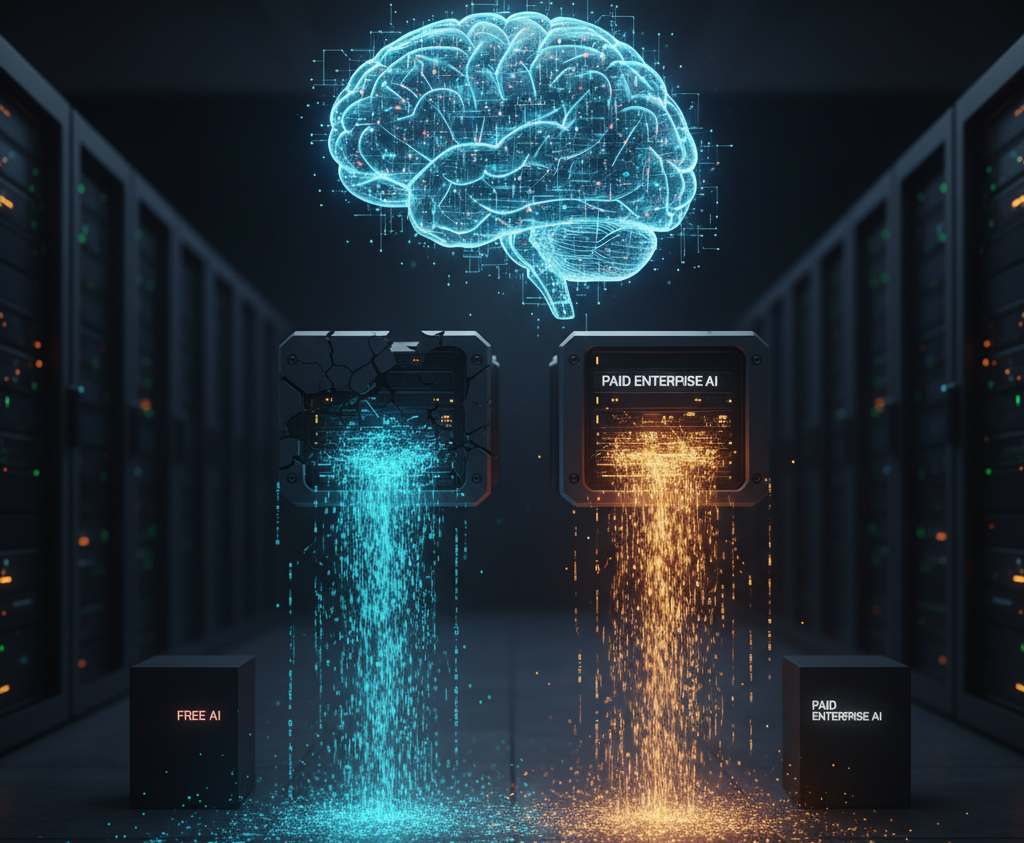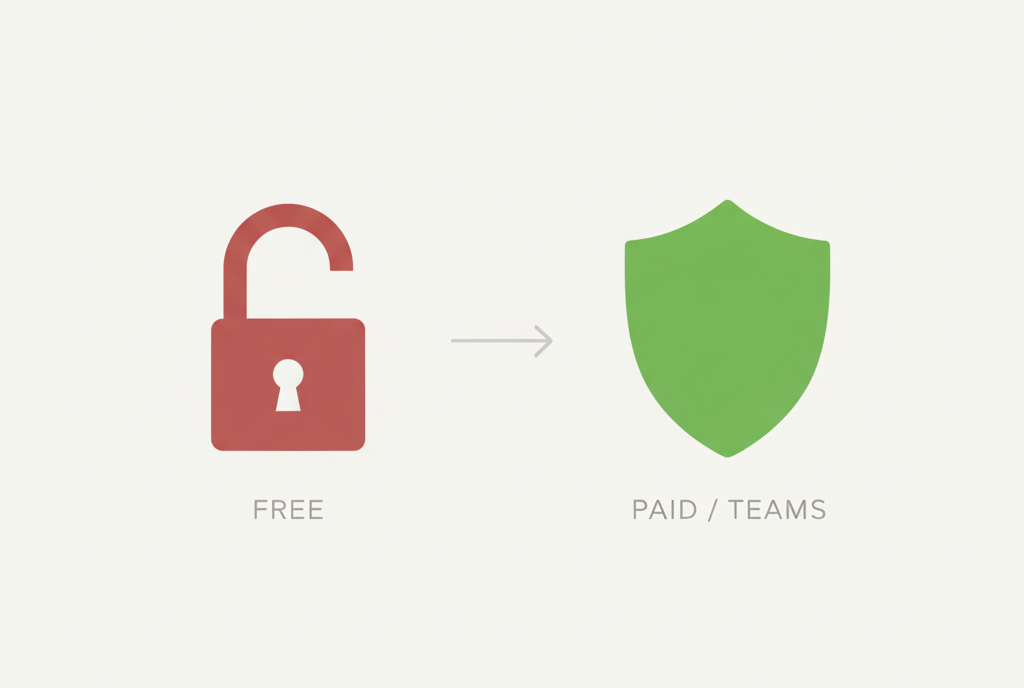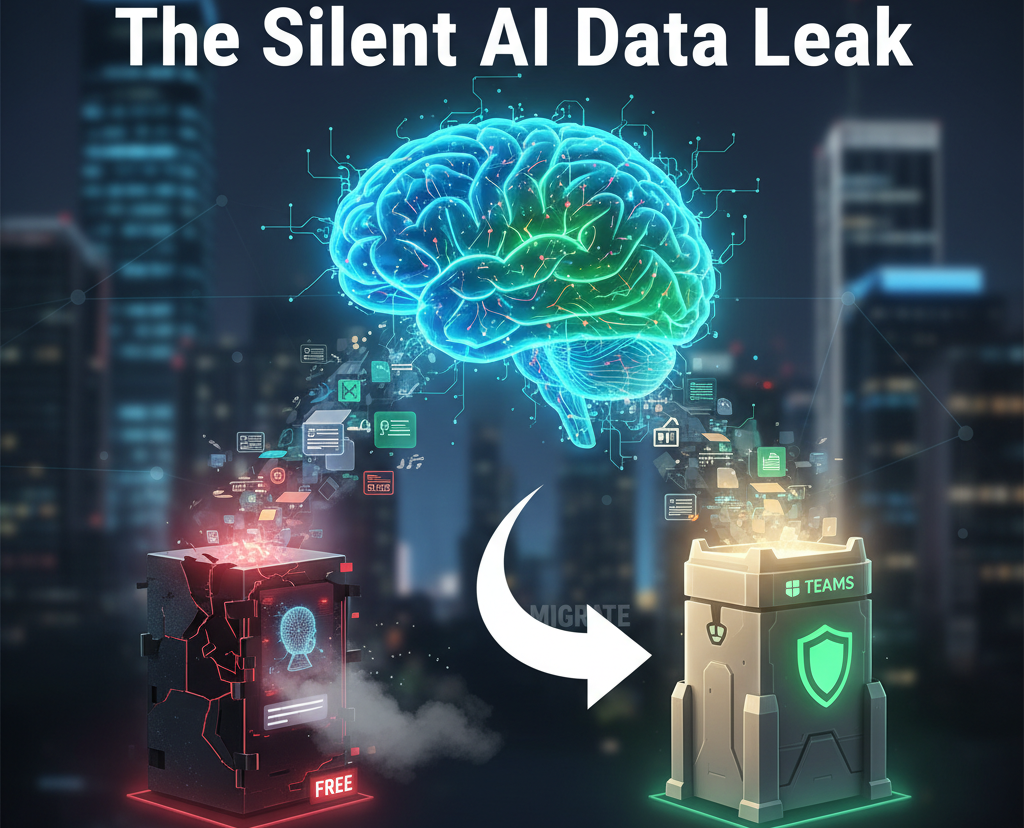The Silent AI Data Leak in Your AI Tools: Why Most Businesses Are Unknowingly Exposing Secrets to ChatGPT, Copilot, and Claude
One in every 54 AI prompts from enterprise networks contains sensitive data. That’s customer info, contract details, internal strategy, access credentials, stuff your competitors would literally pay for. (And quick note: a lot of reports get this wrong, but that stat comes from Check Point Research). Your team is probably doing it right now, and you have no idea.
So here’s what we’re gonna do: I’m gonna show you exactly where your secrets are leaking, why your vendor agreements aren’t protecting you, why November is when this gets worse, and the 3 step setup that’ll stop it before it happens.
The Problem: Shadow AI Is Your Biggest AI Data Leak Blind Spot
Here’s the thing, and this is what keeps me up at night when I’m working with firms. Everybody’s focused on ransomware and phishing. But the real problem is happening quietly, every single day, while your IT team is looking the other way. It’s called Shadow AI, and you probably have it running in your office right now.
Your team is using ChatGPT. Not the enterprise version with all the controls. The free version. Or Google Gemini. Or Claude. And they’re pasting things into these tools that should never leave your building. Not on purpose, they’re trying to solve a problem, move fast, and boom, sensitive information is now in an external AI system.
Let me give you some numbers that actually matter. According to research from Q2 2025, ChatGPT is where 72.6% of all prompt-based data leakage happens. Not because ChatGPT is the worst tool, it’s because it’s the most popular.
But here’s where it gets scary. Of all the sensitive data leaking into GenAI tools, 26.3% goes through ChatGPT Free. That’s not a typo. Nearly a third of all corporate data exposure to ChatGPT comes through uncontrolled, unsecured, free accounts where OpenAI explicitly reserves the right to use your data for training purposes.
Even worse? File uploads. Your team isn’t just typing sensitive data into these tools, they’re uploading entire documents. Spreadsheets with client lists. PDFs with financial models. Contracts with confidential terms. When organizations upload files to GenAI platforms, 21.86% of those files contain sensitive data.
The breakdown? 32.8% of that leak involves source code, access credentials, or proprietary algorithms. Your competitive advantage, sitting on someone else’s servers. Another 18.2% is M&A documents and investment models. 17.8% is PII, customer or employee records that now have regulatory consequences. And 14.4% is internal financial data.
Why This Matters More in November (And Beyond)
You know what’s weird? November is when this gets worse. Remote work increases during the holidays. Employees are working from coffee shops, hotel networks, their home WiFi. Security posture drops. Urgency goes up. Someone’s on a deadline, they paste a contract into ChatGPT to get a quick summary, boom, there it is, gone forever.
But there’s a bigger issue nobody’s talking about. When you send data to a free GenAI tool, you’re not just risking a data breach today. You’re potentially feeding that information into the AI’s training model. That means your proprietary strategy, your client list, your pricing model could influence how the AI responds to your competitors’ prompts six months from now. You’re helping them without even knowing it.
And compliance? Forget about it. If you’re in finance, healthcare, construction, or legal, you have regulations about where data can go. GDPR. HIPAA. PCI DSS. California Consumer Privacy Act. If your team uploads sensitive data to an unauthorized third party AI tool, you’re violating these regulations. Not maybe. Actually.
The Real Cost of “Just One Leak”

Let’s get specific. A Samsung employee accidentally leaked confidential source code into ChatGPT. One person, one prompt, one lapse in judgment. That incident exposed the company’s competitive advantage and created a cascade of security reviews, damage control, and vendor notification requirements. And they’re not alone.
This isn’t even about malicious insiders. This is about good people doing their job, not realizing what they’re putting into a tool. A law firm partner summarizes a contract in free ChatGPT to save 20 minutes. An accountant pastes three years of tax returns into a free tool to get help organizing deductions. Each one thinks it’s private. Each one is wrong.
Here’s what happens next:
- The Immediate Cost: When your client finds out their confidential information was uploaded to ChatGPT without their consent, they’re done. One incident, gone. And they tell two other clients who also leave.
- The Regulatory Cost: Audits, notifications, potential fines. Depending on industry and jurisdiction, we’re talking tens of thousands to hundreds of thousands of dollars.
- The Hidden Cost: Your team now can’t use AI at all because you’ve overcorrected. You’ve built so much fear around “don’t use unapproved tools” that you’ve killed productivity and innovation. Except… they still use the tools, just more secretly.
The Vendor Agreement Trap (Why “It’s Private” Isn’t True)
Here’s what a lot of business owners believe: “We’re using the enterprise version of ChatGPT, so our data is private.” Nice thought. And mostly accurate, but you need to know the difference.
Let me walk you through what actually happens.
- ChatGPT Free/Standard: OpenAI explicitly states that your data may be used to train future models. Your prompts? Fair game. They’re in the training data. This is the number one source of an AI data leak.
- ChatGPT Teams / Enterprise: This is the solution. They promise they won’t use your data for training. Good. This is what you pay for. But where’s the data stored? How long is it retained? What happens if there’s a security breach on OpenAI’s end? You’ve got limited visibility and zero control over infrastructure you don’t own, which is why we still need “smart-use” rules.
- Google Gemini, Claude, Perplexity: Each one has different data handling policies between their free and paid tiers. Most employees don’t know the difference, so they’re using whatever’s easiest, which is usually free tier with no privacy controls whatsoever.
The One Question Your AI Tool Provider Won’t Want to Answer (But You Need To Ask)
This is critical. When you’re evaluating whether to approve an AI tool for your team, here’s the question that matters most:
“After a prompt is submitted and our conversation ends, where does that data live, for how long, and who has access to it? And can you please send me the Data Processing Agreement that guarantees you won’t train on my data?”
If you get anything other than a crystal clear answer and a legal agreement, don’t use the tool for sensitive data. This isn’t paranoia. This is due diligence.

The Solution: Three Moves to Prevent an AI Data Leak This Week
You don’t need an expensive security consultant. You need a practical framework. For a small business, this is the most effective one.
Move 1: Create a Simple “Two-Tier” AI Policy (90 minutes, this week) Your policy needs two very different levels of rules: one for unapproved free tools and one for the paid business tools. This stops the leaks while encouraging productivity.
- Tier 1: UNAPPROVED / FREE TOOLS (The “Red Light”) (e.g., ChatGPT Free, free Google Gemini, etc.)
- Tier 2: APPROVED / BUSINESS TOOLS (The “Green Light”) (e.g., ChatGPT Teams, Gemini Workspace, Claude Teams, and Enterprise versions)
Move 2: Tell Your Team (30 minutes, this week) This is where most companies fail. They create a policy and don’t communicate it. You need to have one conversation that covers:
- The actual risks. Don’t just scare people. Tell them the truth: “Samsung leaked source code using the free version. We are giving you the paid version to prevent that.”
- What they can and can’t do. Make it simple: “Do not ever use the free ChatGPT for any work. Use our paid Teams account for summarizing contracts and analyzing data. Here’s why the difference matters…”
- Why it matters. Not “because security says so.” Because “if we leak client data, we lose the client. If we leak trade secrets, we lose our competitive advantage. The paid tools protect us.”
- What to do if they accidentally use a tool wrong. This is key, you want them to report it, not hide it. “If you paste something into the free ChatGPT and realize you shouldn’t have, tell us. We fix it. We don’t fire you.”
Cost: 30 minutes and better security posture than 95% of SMBs.
Move 3: Set Up One Technical Guardrail (2-3 hours, then it runs on autopilot) You don’t need every tool. You need visibility. Your goal is to spot “Shadow AI” (the free tools) being used, so you can migrate that person to your paid, safe tools.
You have three options:
- Browser based monitoring: Some solutions can flag when an employee is about to upload a sensitive file to free ChatGPT and ask “are you sure? You should use our paid Teams account instead.” Not intrusive, but effective.
- Network level: Your IT provider can monitor connections to known GenAI platforms and flag anomalies or block the free-tier sites entirely.
- Log review: Most platforms have usage logs. You don’t need to review every prompt (privacy nightmare). Just monthly spot checks to see if anything looks off.
The goal isn’t surveillance. It’s visibility and migration. You want to find people using the wrong tools so you can move them to the right ones.
The Bottom Line
AI adoption is no longer experimental. It’s mainstream. Your team is using these tools whether you’ve approved them or not.
This isn’t about stopping AI adoption. It’s about guiding it. The firms winning right now are the ones using AI to move faster, smarter, more efficiently. But they’re doing it safely. They’ve got boundaries. They’ve got oversight. They’ve got a framework.
You’re not protecting your team by blocking AI. You’re protecting them by guiding AI. Start this week. Create this “Two-Tier” policy. Tell your team why it matters. Add one guardrail for visibility. Then sleep a little better knowing that your secrets aren’t training the next version of ChatGPT.
FAQ
Q: If I approve ChatGPT Enterprise, is my data completely safe?
A: Safer, but not “completely safe”. “Safer” means OpenAI contractually agrees not to use your data for training its public models. That’s a huge step up from the free version and the #1 risk you’re solving. However, your data is still leaving your network and sitting on OpenAI’s infrastructure. The remaining risk isn’t training, it’s a breach on their end. You are trusting their security. This is true on any cloud platform, so it is important to have good cybersecurity practices, and a good cybersecurity team.
Q: What if an employee already leaked something to free ChatGPT?
A: First, don’t panic. Second, find out exactly what was leaked. Third, contact OpenAI’s support to request data deletion if possible (though guarantees are limited). Fourth, assess the risk: if it was PII or client confidential data, you must notify affected parties as required by law or your contracts, and or Incident Response plans. Fifth, and most important, use it as a learning moment to move them to the paid, secure tool.
Q: Does this AI data leak risk apply to free ChatGPT and paid versions?
A: The biggest risk, data being used for training, applies only to the free versions. That’s the main “leak” we’re fixing. Paid and enterprise versions solve this. The secondary risk, a potential breach of the provider, applies to all versions, but this is a much smaller, more manageable risk that you accept when using any cloud vendor.
Q: Can I just ban all AI tools?
A: You could. But let’s be honest: your team will hate you, productivity will tank, and they’ll use the tools anyway. They’ll just do it secretly on their personal phones and home networks, where you have zero visibility. That’s infinitely worse. It’s better to have the “Two-Tier” framework that lets people use AI safely than to pretend you can ban it.
Q: We are a small business. Can’t we just use the free tools and tell people “don’t paste sensitive data”?
A: You can, but it never works. The line between “sensitive” and “not sensitive” is blurry. An employee’s draft email to a client, a snippet of code, a list of sales targets… it all paints a picture. The only way to be safe and productive is to pay for the business versions (ChatGPT Teams, etc.) where your data is private by default.
Sources
- https://www.harmonic.security/blog-posts/genai-data-exposure-report-fa6wt
- https://go.layerxsecurity.com/hubfs/LayerX_Enterprise_GenAI_Security_Report_2025.pdf
https://www.cyberhaven.com/blog/ai-at-work-is-exploding-but-71-of-tools-put-your-data-at-riskhttps://www.cybersecuritydive.com/news/Samsung-Electronics-ChatGPT-leak-data-privacy/647219https://www.mayerbrown.com/en/insights/publications/2025/10/2025-cyber-incident-trends-what-your-business-needs-to-know



